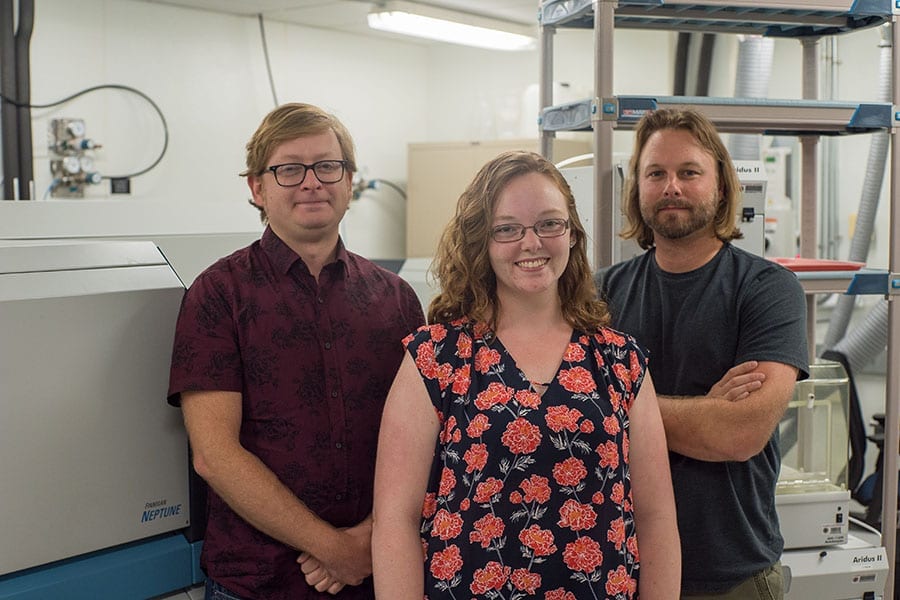
Late in the prehistoric Silurian Period, around 420 million years ago, a devastating mass extinction event wiped 23 percent of all marine animals from the face of the planet.
For years, scientists struggled to connect a mechanism to this mass extinction, one of the 10 most dramatic ever recorded in Earth’s history. Now, researchers from Florida State University have confirmed that this event, referred to by scientists as the Lau/Kozlowskii extinction, was triggered by an all-too-familiar culprit: rapid and widespread depletion of oxygen in the global oceans.
Their study, published today in the journal Geology, resolves a longstanding paleoclimate mystery, and raises urgent concerns about the ruinous fate that could befall our modern oceans if well-established trends of deoxygenation persist and accelerate.
Unlike other famous mass extinctions that can be tidily linked to discrete, apocalyptic calamities like meteor impacts or volcanic eruptions, there was no known, spectacularly destructive event responsible for the Lau/Kozlowskii extinction.
“This makes it one of the few extinction events that is comparable to the large-scale declines in biodiversity currently happening today, and a valuable window into future climate scenarios,” said study co-author Seth Young, an assistant professor in the Department of Earth, Ocean and Atmospheric Science.
Scientists have long been aware of the Lau/Kozlowskii extinction, as well as a related disruption in Earth’s carbon cycle during which the burial of enormous amounts of organic matter caused significant climate and environmental changes. But the link and timing between these two associated events — the extinction preceded the carbon cycle disruption by more than a hundred thousand years — remained stubbornly opaque.
“It’s never been clearly understood how this timing of events could be linked to a climate perturbation, or whether there was direct evidence linking widespread low-oxygen conditions to the extinction,” said FSU doctoral student Chelsie Bowman, who led the study.
To crack this difficult case, the team employed a pioneering research strategy.
Using advanced geochemical methods including thallium isotope, manganese concentration, and sulfur isotope measurements from important sites in Latvia and Sweden, the FSU scientists were able to reconstruct a timeline of ocean deoxygenation with relation to the Lau/Kozlowskii extinction and subsequent changes to the global carbon cycle.
The team’s new and surprising findings confirmed their original hypothesis that the extinction record might be driven by a decline of ocean oxygenation. Their multiproxy measurements established a clear connection between the steady creep of deoxygenated waters and the step-wise nature of the extinction event — its start in communities of deep-water organisms and eventual spread to shallow-water organisms.
Their investigations also revealed that the extinction was likely driven in part by the proliferation of sulfidic ocean conditions.
“For the first time, this research provides a mechanism to drive the observed step-wise extinction event, which first coincided with ocean deoxygenation and was followed by more severe and toxic ocean conditions with sulfide in the water column,” Bowman said.
With the oxygen-starved oceans of the Lau/Kozlowskii extinction serving as an unnerving precursor to the increasingly deoxygenated waters observed around the world today, study co-author Jeremy Owens, an assistant professor in the Department of Earth, Ocean and Atmospheric Science, said that there are still important lessons to be learned from ecological crises of the distant past.
“This work provides another line of evidence that initial deoxygenation in ancient oceans coincides with the start of extinction events,” he said. “This is important as our observations of the modern ocean suggest there is significant widespread deoxygenation which may cause greater stresses on organisms that require oxygen, and may be the initial steps towards another marine mass extinction.”
Learn more: Oxygen depletion in ancient oceans caused major mass extinction
The Latest on: Depletion of oxygen in the global oceans
[google_news title=”” keyword=”depletion of oxygen in the global oceans” num_posts=”10″ blurb_length=”0″ show_thumb=”left”]
via Google News
The Latest on: Depletion of oxygen in the global oceans
- Impacts of 2020 Red Tide Event Highlighted in New Studyon April 25, 2024 at 9:00 am
At peak bloom, conditions are often hyperoxic for longer periods due to the increased amount of oxygen in the water. As the bloom starts to decline — either due to the natural lifecycle of these ...
- From the coast to the deep sea, changing oxygen levels affect marine life in different wayson April 23, 2024 at 10:50 am
Earth's atmosphere maintains a constant level of oxygen, whether it is a wintry, rainy day or hot summer. Across the ocean, oxygen concentrations vary enormously between different places and over time ...
- Tropical cyclones may be an unlikely ally in the battle against ocean hypoxiaon March 31, 2024 at 5:00 pm
Tropical cyclones, also known as hurricanes and typhoons, are meteorological phenomena that occur over tropical and subtropical oceans experiencing ... to alleviate oxygen depletion and anoxia ...
- Unveiling the Threat How Additional Nutrients Intensify Dead Zones in Oceanson March 26, 2024 at 3:32 am
The health of our oceans is under threat as human activities continue to release excessive nutrients into marine environments. These nutrients, primarily nitrogen compounds, fuel the growth of algae, ...
- Clues from the last ice age help predict oceans' response to continued warmingon January 19, 2024 at 1:04 pm
By examining isotopes of the metal thallium trapped in these sediments, they could reconstruct the average global ocean oxygen levels thousands of years ago. Wang explained that this approach of ...
- From ozone to oxygenon June 23, 2022 at 1:36 pm
The above image shows the nine planetary boundaries diagram depicted in a circle which, starting from 12 o'clock and running clock-wise, include: climate change, novel entities, stratospheric ozone ...
- 5 reasons you should care about our oceanon June 21, 2022 at 5:24 pm
Our ocean is in serious trouble. Heating, pollution, acidification, and oxygen loss pose serious threats ... ocean and its biodiversity provide our global community with 15 per cent of the animal ...
- FAQ: Ocean Deoxygenationon June 17, 2021 at 5:29 pm
In contrast, oxygen gets used by the organisms that live in the ocean in the process of respiration. Figure from Global Ocean Oxygen Network, Breitburg, D., M. Gregoire, K. Isensee (eds.) 2018. The ...
- Sustainable Development Goal 14on April 3, 2019 at 7:47 am
The world’s oceans ... global systems that make the Earth habitable for humankind. Our rainwater, drinking water, weather, climate, coastlines, much of our food, and even the oxygen in ...
- Abu Dhabi's Ocean Summit Warns of World Fish Depletion by 2030on March 10, 2019 at 5:31 am
Global governments ... “Because of climate change, the ocean is warming and is losing oxygen directly through the carbon the ocean is absorbing — it is becoming more acid; it is becoming ...
via Bing News










